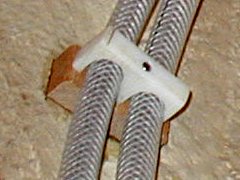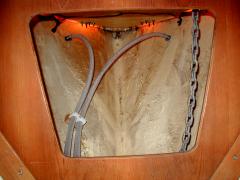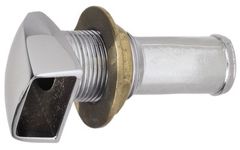Venting the tank
 Two 3/4" ID vent hoses run forward to the bow. If you've ever read Peggie Hall's pamphlet, Marine Sanitation: Fact vs. Folklore, then you'll understand that you need a flow of air in and out of the tank. This means big vent hoses, short straight runs, and a scheme that moves the air through the tank. In this installation, the vent hoses are not as short and direct as I'd like. And they're only 3/4" because that's what worked with the tank and through-hull vents. But it's adequate.
Two 3/4" ID vent hoses run forward to the bow. If you've ever read Peggie Hall's pamphlet, Marine Sanitation: Fact vs. Folklore, then you'll understand that you need a flow of air in and out of the tank. This means big vent hoses, short straight runs, and a scheme that moves the air through the tank. In this installation, the vent hoses are not as short and direct as I'd like. And they're only 3/4" because that's what worked with the tank and through-hull vents. But it's adequate.
 The hoses are held level with clamps I fabricated out of a scrap of 3/4" polyethelyne board. It's important to eliminate low spots where moisture might accumulate and block the airflow.
The hoses are held level with clamps I fabricated out of a scrap of 3/4" polyethelyne board. It's important to eliminate low spots where moisture might accumulate and block the airflow.
 The key to the airflow through the tank is mounting a vent on each side
of the bow. In the same manner that air flowing along the sail creates a
high-pressure zone on one side and a low-pressure zone on the other, so it
is with the airflow down the hull. As long as the airflow is not exactly
symmetrical, the same effect will be seen. Since the pressure will be
greater on one side relative to the other virtually all of the time,
air will flow through from that side to the other.
The key to the airflow through the tank is mounting a vent on each side
of the bow. In the same manner that air flowing along the sail creates a
high-pressure zone on one side and a low-pressure zone on the other, so it
is with the airflow down the hull. As long as the airflow is not exactly
symmetrical, the same effect will be seen. Since the pressure will be
greater on one side relative to the other virtually all of the time,
air will flow through from that side to the other.
 I've been asked about the through-hull vents I used.
Mine are Perko gas tank vents, mostly because there was already one such on the port bow from the previous owner's installation of a Mansfield TDX treatment system. I suspect ordinary mushroom through-hulls might work as well.
I pointed the scoop aft and slightly down to avoid taking on water which could block the airflow in the hose.
I've been asked about the through-hull vents I used.
Mine are Perko gas tank vents, mostly because there was already one such on the port bow from the previous owner's installation of a Mansfield TDX treatment system. I suspect ordinary mushroom through-hulls might work as well.
I pointed the scoop aft and slightly down to avoid taking on water which could block the airflow in the hose.
Special thanks to Mike Lehman of Gilleleje, #505, and Jim Mennucci of Quest, #433, who blazed the trail with the Kracor tank.
- The Folding Sink
- Installing a Raritan holding tank in a newer A30
- A custom holding tank for the older boats
- Boat Maintenance
- Spars, Sails & Rigging
- Hull & Deck
- Deck Gear
- Steering
- Mechanical Propulsion
- Electrical
- Head
- Plumbing
- Accomodations
- Tools
- disorganized







